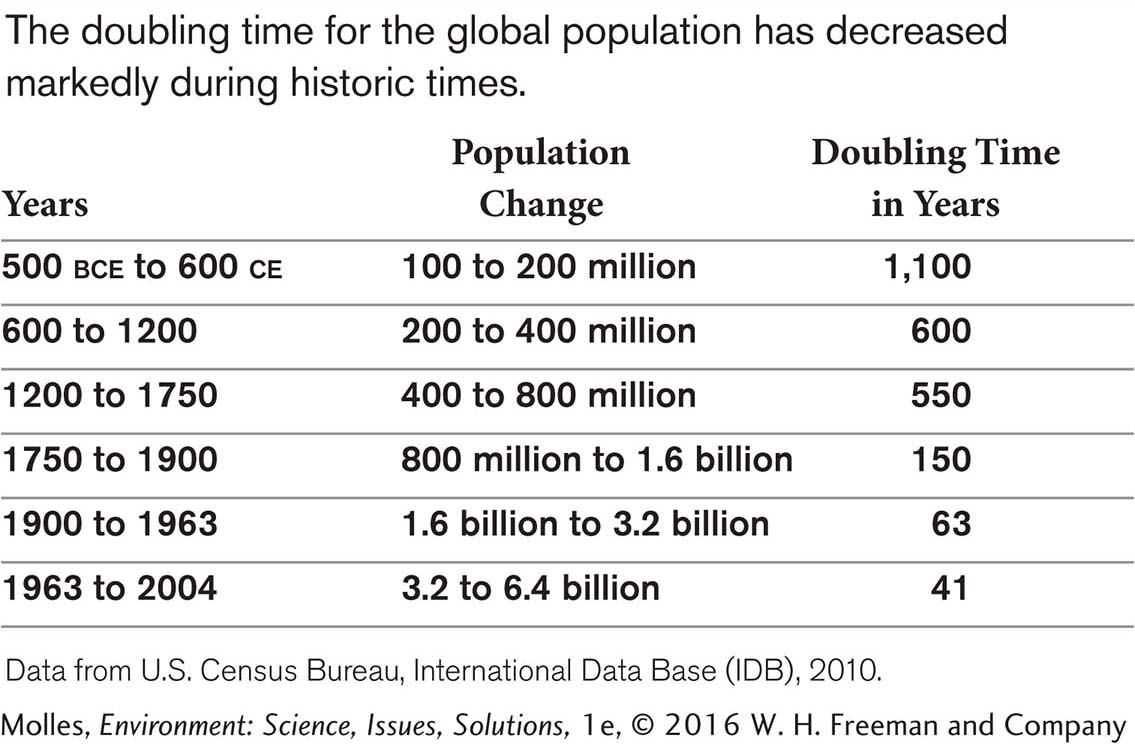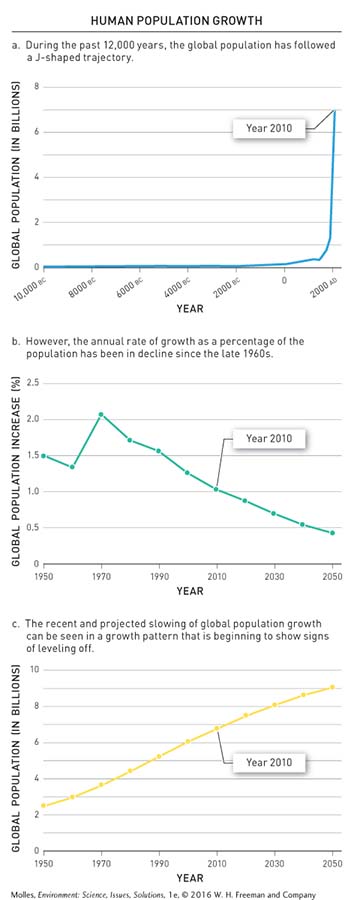5.2 The global population will grow into the middle of this century

At its rate of growth in 2015, the U.S. population would double in 91 years. Given this growth rate, what sorts of changes in housing, population density, and infrastructure would you expect to see in your lifetime?
Some 60,000 years ago, a few thousand people in East Africa began a historic migration into the Middle East, Europe, Asia, and beyond. While there is some debate among archaeologists and geneticists about the exact timing and process of human dispersal from Africa, we know that, in the early years, the global human population grew very slowly. Then, with the shift from hunting and gathering to agriculture, approximately 10,000 years ago, populations began to swell—but numbers remained in the few hundred million. About 500 years ago, the global population began to grow more rapidly, climbing to 1 billion by 1804. The rate of population growth increased with the Industrial Revolution in the mid-1800s, because of improved sanitation, health care, and increased agricultural production. Consequently, the global population grew to 2 billion by 1930 and to 3 billion just 29 years later, in 1959.
population doubling time The amount of time required for a population, growing at a particular rate, to double its size.
One way to think about the quickening pace of human population growth is to calculate the population doubling time, the amount of time required for a population, growing at a particular rate, to double its size. As shown in Table 5.2, the doubling time for the global population has been declining—that is, the amount of time it takes for the population to grow to twice its size is growing shorter. For example, it took all of human history for the population to reach 3.2 billion in 1963. The population grew by another 3.2 billion people by 2004, requiring only 41 years. As of 2015, the rate of global population growth had slowed to the point where the doubling time for the global population had increased to 66 years. However, it is unlikely that the population will double again, since the trend is for continued declines in population growth rates. As a result, the best current population models predict a leveling off of the global population at a size far lower than double its size in 2015.
DOUBLING TIMES FOR THE GLOBAL POPULATION

The global population has followed a J-shaped curve over much of the past five centuries (Figure 5.3a). Although the global population (total population number) continues to increase, it is not increasing as quickly as it formerly did (Figure 5.3b). In other words, the growth rate is slowing down. The population growth rate peaked in the late 1960s and early 1970s and has been decreasing steadily since then, as birthrates have fallen worldwide. The current theoretical doubling time of the population is 66 years. However, population biologists predict that the growth rate will keep slowing into the next half-century (Figure 5.3c), which will increase doubling time as population growth slows. A slowing global population growth rate will resemble an S-shaped curve (for more on J- and S-shaped curves, see Chapter 3).
THREE VIEWS OF GLOBAL POPULATION GROWTH

FIGURE 5.3 The perspective you develop on population growth is significantly affected by how you examine it. For example, although total global population is still increasing, the pace at which the population is increasing has slowed over the past 40 or so years. (Data from U.S. Census Bureau, International Data Base, 2010)
Does leveling off of the human population sometime this century mean that we will be at carrying capacity? In Chapter 3, we defined carrying capacity as the average number of individuals in a population that the environment is capable of supporting over the long term. Recall that if present trends in population growth and resource consumption continue, by 2050 we will need the productive capacity of nearly three Earths to support the expected human population over the long term. Some scientists have estimated that Earth could supply enough food to support a population of 9 to 10 billion humans—but only if we were all vegetarians. However, human carrying capacity is influenced by a host of environmental factors besides food, including supplies of freshwater, availability of critical energy supplies, and capacity of built and natural systems for waste disposal. What is clear is that the human carrying capacity will be determined by a combination of limits set by the natural environment and by the choices we make as individuals and societies.
Think About It
What environmental factors produced the very rapid growth of human populations following the Industrial Revolution?
Why is it impossible for the global population to sustain J-shaped population growth indefinitely? (Hint: Check out Chapter 3 for more on J-shaped growth curves.)
What environmental factors may ultimately limit global population growth?


